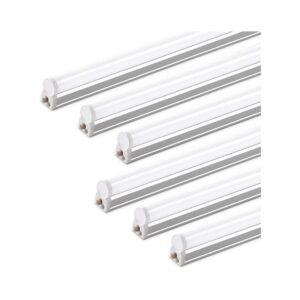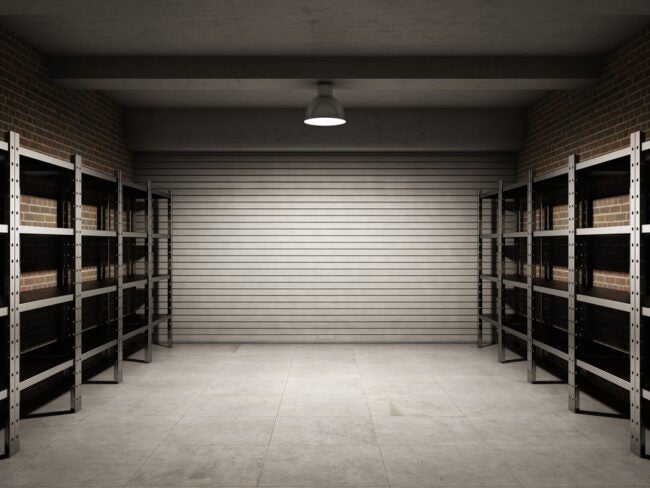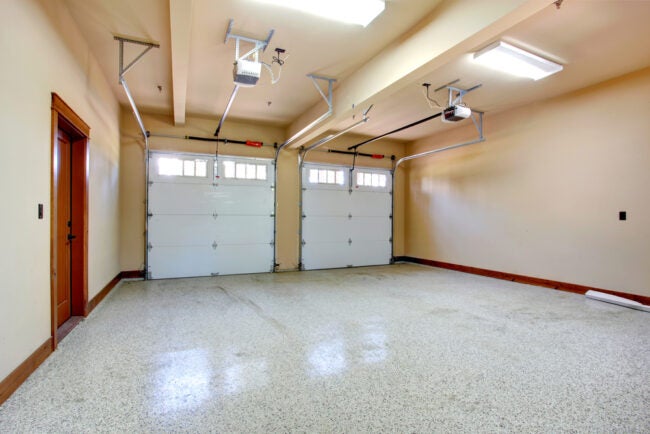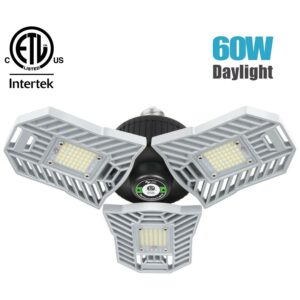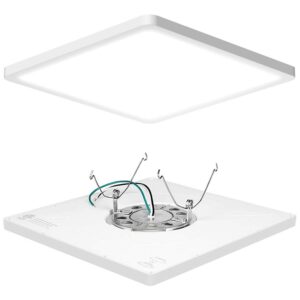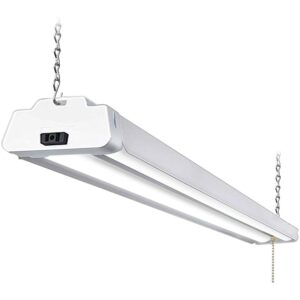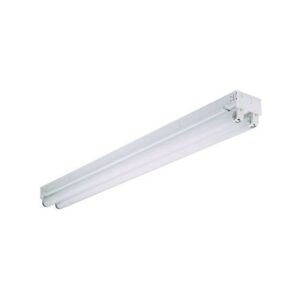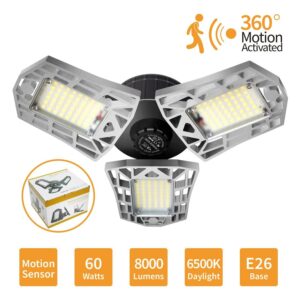Whatever work you do in your garage, it helps to have sufficient lighting. Dismal, dimly-lit garages are not only difficult to work in, they can be hot spots for injuries. You could trip over a cord or a hose, accidentally cut yourself on an object you didn’t see—poor lighting in this space can be dangerous.
The best garage lighting will transform a dark space with potential hazards into a safer, brighter environment you can feel comfortable working in—and fortunately, there’s a ton of quality products to choose from. You can swap out fluorescent fixtures for energy efficient LEDs, install a screw-in, multi-position light bulb, and otherwise—easily and affordably—upgrade the illumination in your garage. So read on to get a sense of the features to look for and to find out why the following options reign supreme as some of the best garage lighting available.
- BEST OVERALL: (Pack of 6) Barrina LED T5 Integrated Single Fixture
- BEST BANG FOR THE BUCK: Falive Garage Lighting Three-Leaf Led Garage Light
- BEST FLUSH MOUNT: AVANLO Super Slim LED Ceiling Light Fixture
- BEST FOR WORKBENCH: Hykolity LED Shop Light
- BEST INDUSTRIAL: Sunco Lighting 2 Pack Industrial LED Shop Light
- BEST FLUORESCENT: Lithonia Lighting Fluorescent Ceiling Fixture
- BEST MOTION-ACTIVATED: Craftersmark LED Garage Lights with Motion Sensor
Types of Garage Lighting
Gone are the days of incandescent bulbs. While there was never an actual incandescent bulb ban, those old-school energy suckers are harder to find now. And if you do see them on the shelf, don’t be fooled by the low price: They could cost you more when the energy bill comes in. Instead, most people choose between LED and fluorescent lighting. Each has its pros and cons, so it’s important to pick what’s best for your space and work style.
LED
LED stands for “Light Emitting Diode,” which is a fancy way for saying there’s a tiny component inside of the light that illuminates when electricity passes through it. These bulbs are a popular choice due to their brightness, energy efficiency, and the fact that they’re long lasting.
The reason you often see LEDs in objects like flashlights and spotlights is that they generate directional light—casting a very bright beam straight out from the diode that concentrates on a small area. Garage lighting manufacturers compensate for this in two ways: They make LEDs with multi-positional wings and install reflectors to distribute the light evenly throughout a space. Both offer an excellent alternative to the wide-cast lighting of incandescent bulbs.
Fluorescent
With fluorescent lighting, a mercury-vapor gas produces light instead of a solid filament like an incandescent bulb, or a diode like an LED. The gas in a fluorescent bulb emits ultraviolet light when electrified.
The benefit of fluorescent lighting—in general, and for garage-type work specifically—is that it distributes light very evenly. That gas is enclosed in long glass tubes, so the light shines out in a 360-degree pattern. The trouble with fluorescent lighting is that, though long-lasting, they must be taken to a hazardous material disposal center when they do burn out. Due to the toxicity of mercury gas, fluorescent bulbs aren’t convenient to throw away or recycle, as LEDs are.
What to Consider When Buying Garage Lighting
While shopping for the best garage lighting, keep these important factors in mind.
Brightness
Garages receive little or no natural light, so when upgrading your lighting setup, choose fixtures that put out a lot of bright light. The lighting industry measures brightness by lumens—a measure of light produced during a specific period of time. Bottom line: The more lumens, the brighter the lighting will be.
Lumens are not the same as watts. Watts measure energy used, lumens measure brightness. However, for the sake of comparison, a 75-watt bulb produces about 1100 lumens. As a general rule, the ideal lumen range for workshop and garage lighting is around 3500 lumens.
Color Temperature
Color temperature refers to the color the light produces and is measured on a Kelvin scale. Temperatures range between 3500K and 6000K, with the lower end being warmer and more yellow and the higher-end cooler and bluer.
Most garages tend to be gray and industrial, so cooler lighting temperatures are usually the most flattering, while warmer temperatures can give the floor a dingy look. Aim for a temperature in the area of 5000K. The light produced by a 5000K bulb will be slightly blue but not glaring or harsh to your eyes.
Some fixtures come with adjustable color temperatures, allowing you to bounce through the range and choose the color temperature that works best for you.
Energy Efficiency
Regardless of what lighting system you choose for your garage, a modern fixture will use far less energy than older incandescent bulbs. Fluorescent bulbs can cut energy consumption by around 70 percent over an incandescent bulb producing the same amount of light. LED bulbs are even better, cutting as much as 90 percent of the energy consumption of a comparable incandescent bulb. Factor in that they last much longer (over 10,000 hours compared to an incandescent bulb’s 1,000 hours), and the savings are tremendous.
Installation and Connectivity
Installation and connectivity may play a large role in deciding on the best garage lighting fixtures. If you don’t have a lot of electrical experience, there are easy-to-install options that produce great results. The Easiest way to upgrade your garage lighting is with screw-in bulb replacements. These aren’t just bulbs, but multi-positional LED fixtures that screw into your basic light base. They don’t require any extra wiring or much effort on your part.
There are other plug-in systems that you can string throughout your garage to produce a tremendous amount of light. These systems work through standard outlets: Simply plug them in and turn on their light switch. They often include “jumper” wires that will connect a set of lights together, illuminating your entire garage, and most times, they install with simple clips.
Fluorescent lighting, on the other hand, requires a bit more during installation. These lights have ballasts that regulate the voltage to the light bulb. You must hardwire these lights into your garage circuit. While not overly complicated, it is a more involved process.
Longevity
An LED bulb can last 25 to 30 times longer than an incandescent, all the while reducing the amount of energy consumed. A fluorescent bulb can last as long as up to 9,000 hours compared to an incandescent bulb’s 1,000 hours. The reason LEDs and fluorescents last so much longer than incandescent varieties is that they don’t have a sensitive, fragile filament that can break or burn up.
Climate
If you live in an area that experiences bitter cold winters and you have an unheated garage, LED bulbs are the most suitable choice. In fact, LEDs become more efficient in colder temperatures. Since they don’t need to heat up, they become bright immediately and produce consistent, energy-efficient light in very cold temperatures. By contrast, many fluorescent lights cannot operate if the air temperature is below 50 degrees Fahrenheit. If you live in an area where the temperature drops well below freezing, the best garage lighting system is an LED setup.
Other Features
While upgrading the overhead lighting system, if you work on projects in the garage, remember to make sure your workstation is adequately illuminated as well. You could hang a chain from the ceiling to lower a fixture, attach an LED light below a cabinet—however you prefer to establish direct task lighting. There are plenty of great options, and you can even use a combination of systems. While a general overhead fixture is great, adding an illuminated, positionable arm (like those used by fly-tying fishermen) can make it easier to see small parts.
Motion sensors can also make garage lighting more convenient and safer. Some LED systems have sensors that will turn the lights on when they detect someone walking or moving in the garage. Not only will you be able to illuminate your garage without fumbling for a light switch, motion sensors can deter unwanted guests from helping themselves to your tools and other belongings.
If the only option you’re comfortable with is replacing your incandescent bulbs with screw-in LED units, choose some with multi-positional wings. These fixtures can make a huge difference in your garage lighting’s effectiveness. If you find that you’re not getting enough light in a particular area, you can position a wing in that direction to improve illumination. Since LEDs don’t get nearly as hot as incandescent or fluorescent bulbs, they’re often cool enough to touch bare-handed after just a few seconds. This also keeps your LEDs running as efficiently as possible.
Our Top Picks
Deciding on a garage lighting system or fixtures can be a challenge, but now that you know what to look for, these high-performing lights are a great place to start.
Photo: amazon.com
If you want to light up your entire garage with plenty of lumens—while staying on budget—this set of LED T5 single fixtures from Barrina is a smart choice. This pack of six (also available in an eight-pack) delivers 2200 lumens for each light, which all wire together with simple plug-in jumpers. Just plug them into an existing outlet, clip in place, and your entire garage’s lighting system is complete.
Each Barrina light is 4 feet long, features a very cool 6500k color temperature, and uses very little power (20w per section). And since they’re LEDs, they’ll work very well in very cold environments—so no excuses for not tackling those jobs when chilly weather arrives!
Photo: amazon.com
If your garage lighting only includes screw-in bases, Falive Garage Lighting has you covered with the Three-Leaf Led Garage Light. This inexpensive 60 watt (total) fixture provides plenty of light, at 2000 lumens per leaf with a 6000K color temperature. That means you get a highly efficient light fixture capable of 6000 lumens and a cool temperature—suitable for most garage settings. The aluminum body dissipates any heat build-up, keeping the LEDs operating as efficiently as possible. If an area of your garage requires a bit more light, simply position one of the leaves to shine in that direction.
Photo: amazon.com
If you carry lumber or other long materials into your garage regularly, catching the end of a board on your light bulb or fixture will only slow you down. If that’s the case, consider switching to a flush-mount light like the AVANLO Super Slim LED Ceiling Light Fixture, which at 0.6 inches thick will be out of your way. While this light doesn’t include clips or hardware to hang it from the ceiling, it mounts to a standard electrical junction box. You can also retrofit it to work with 5- and 6-inch lighting cans, hardwiring it into your lighting circuit. The AVANLO light is conveniently dimmable, so you can adjust it to your preference.
The AVANLO light is available in both a square and a round shape, and in color temperatures ranging between 3000K and 5000K. While it doesn’t produce a ton of light at 1680 lumens, installing a few throughout your shop will nicely supplement your regular work lights.
Photo: amazon.com
Three things are important for a workbench light: an easy power switch, the ability to hang it, and plenty of light. You’ll get all three from the hykolity LED Shop Light. This light measures 4 feet long—enough to illuminate most work surfaces. The included hanging hardware allows you to suspend it from the ceiling or from under a shelf. The 42-watt LEDs produce plenty of light at 4200 lumens, with a cool-toned 5000K temperature. The pull-chain operated on-off switch is easy to use, so you won’t be fumbling around for it in the dark.
Photo: amazon.com
If you need industrial-level lighting for your garage, check into the Sunco Lighting two-pack of LED shop lights. These 4-foot-long lights provide a 5000K color temperature—ideal for garage settings—and produce an ample 4000 lumens per light. Mount them to the ceiling surface or suspend them with the included hanging hardware and chain. Each light has an on-off pull switch with an included chain that can hold up to an industrial setting far better than string. If you prefer to have all of your lights on one switch, link a few sets and operate them off of a wall switch, or off the pull switch on the first light in the line.
Photo: amazon.com
If ready to replace an older fluorescent fixture, this Ceiling Light Fixture from Lithonia is a good choice. This 4-foot lighting fixture uses T12 fluorescent bulbs (sold separately here), and its housing boasts a high-gloss, baked-on enamel finish to resist heat and reflect as much light as possible.
This Lithonia model comes with a 120v residential ballast, meaning you can wire it right into your garage’s lighting circuit. While the lighting output has more to do with the bulbs than the fixture, this unit can handle any 4-foot T12 bulbs, allowing you to choose the lighting and color temperature that best suits your setting.
Photo: amazon.com
Adding motion-activated lighting to your garage serves three purposes: convenience, energy savings, and security. The Craftersmark LED Garage Light is an excellent choice if you need all three in a bright, affordable package. This 60-watt fixture produces 8000 lumens of cool 6500K light—enough for workshops, garages, warehouses, or anywhere else you might need ample light.
The Craftersmark garage lights have three adjustable panels that allow you direct light wherever you need it as well. It screws into a standard bulb-base, making it a great option for some older garages or even basements. The motion sensor comes on quickly if it senses any movement, providing safe and convenient lighting any time you enter your garage. It will also turn off on its own, saving you money on energy.
The Advantages of Owning the Best Garage Lighting
Being able to see what you’re doing makes a world of difference both while working on a project and with the end result. Poor lighting can be very frustrating, especially if you drop a small piece like a nut or bolt—good luck finding that tiny fastener against a dark floor!
Struggling to see what you’re doing can lead to some undesirable physical effects, such as eye strain and headaches. Factor in the increased chances of a tripping accident, and you’ll be far safer and healthier with proper lighting.
The best garage lighting will also save you money. Not only are the best lighting products much more energy-efficient than older models, but they also burn out less often so you’ll have far fewer bulbs to replace. Even with the higher price of LED and fluorescent bulbs compared to incandescents, you’ll save money in the long run on bulbs alone.
- Better lighting leads to a more enjoyable workflow and environment
- Upgrading your lighting will reduce the chances of accidents and eye strain
- LED and fluorescent bulbs last far longer than incandescents, saving you time and money on bulbs
FAQs About Garage Lighting
If you’re still a bit in the dark about the best garage lighting, check out answers to some commonly asked questions about these products.
Q. What is the difference between lumens, Kelvins, and watts?
Lumens describe the brightness of a bulb. Kelvins describe the temperature color. Watts represent energy consumption. They are not interchangeable terms.
Q. Does a higher color temperature bulb produce more light?
No. A higher temperature bulb produces a cooler, bluer tone, but not more light.
Q. Are LED bulbs brighter than fluorescents?
A bulb’s brightness is dependent on lumen output, not bulb type. When comparing bulbs of similar wattages, LEDs will be more efficient and, therefore, brighter.
Q. Do LED lights lose brightness over time?
Yes, LEDs do lose their brightness over time. They don’t burn out like standard bulbs, but they will slowly become dimmer.
